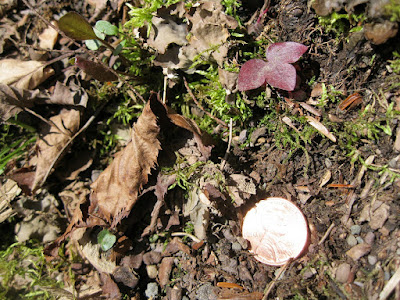Friday, April 29, 2022
Going To Seed
Tuesday, April 26, 2022
Trillium Time
Sunday, April 24, 2022
Open Bloodroot Flowers
Here are today's two stars side by side.
Saturday, April 23, 2022
Another White Pine Hit
That is Becky wearing her pink hat sharing tender moments with Luca, the good neighbor's dog. We are pleased that this white pine dropped its heavy branches without contacting the stone wall or the arbutus patch. After surveying the damage we realized there is nothing we can do about it today.
Friday, April 22, 2022
Damaged Giant
This stately White pine tree grew along the edge of the river bottom field. Fortunately much of it remains intact but it did suffer a huge hit. The ground at the base of this tree features a deep deposit of decayed pine needles. That seemed like a perfect place to transplant Arbutus plants.
Fortunately the broken tree pieces fell toward the river rather than on our land. This loss to the tree is enormous but it appears that enough undamaged tree remains to support continued growth.
This welded wire cage protects the two Arbutus plants placed here. It is designed to keep hungry woodchucks and rabbits away from our plants. The tree debris that fell here was limited to small dead pieces. Both the cage and the plants escaped injury.
Thursday, April 21, 2022
After The Storm
Another trip to Irma's woods was made. Snow was still covering the ground but flowers were found. This bloodroot still tightly wrapped by its protective leaf is visible because of the adjacent vertical stone. It looks like it will survive the storm in fine shape.
The moss covering the stone provides an attractive background for the three lobed liver colored hepatica leaf. The white wood chip between the closed flower and the leaf is likely from one of the storm broken tree branches. Many of the breaks occurred high up in the trees leaving long white scars on the remaining branches.
Monday, April 18, 2022
Ahead Of The Storm
Friday, April 15, 2022
Another Visit To Irma's Woods
Last year was difficult for both the Bloodroot plants in our garden and these restricted to a small section of Irma's Woods. It was questionable whether either would return. Several tightly wrapped white blossoms were pushed from the soil this morning. Tomorrow we will return to see both the open flowers and unfurled leaves. Their time open is limited to just a few days so we will definitely return tomorrow. So far our plants have made no appearance. We did have several appear from seeds last year and anxiously await for any sign that any of these plants remain alive.









































.JPG)





anp.jpg)
anp.jpg)
